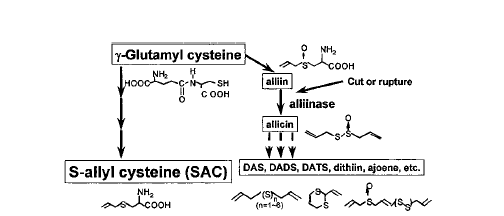Garlic
History
- Used since the beginning of recorded history- found to be recorded on Greek temples and Egyptian pyramids
- Bible, medical texts from Egypt, Greece, Rome, China, and India show medicinal uses for garlic
- Hippocrates prescribed garlic for many conditions
- One of the first performance enhancing agents used in the Olympics
- Codex Ebers, the medical text of authority at this time, contained various uses of garlic
- given to laboring class of Egypt to promote strength
Medicinal Uses

Comparison to conventional therapy
- atherosclerosis (possibly effective)
- cancer (possibly effective)
- gastrointestinal disease (animal data)
- hyperlipidemia (adult, possibly effective; pediatric, ineffective)
- hypertension (possibly effective)
- infection (possibly effective)
Garlic is high in gama-glutamyl cysteine which is converted to S-allyl cysteine (SAC) which is thought to contribute heavily to the health benefits of garlic.
Mechanism of Action
- Cholesterol lowering activity
- - inhibit HMG-CoA reductase (cholesterol synthesis)
- Blood pressure lowering activity
- gamma-glutamylcysteines are the compounds in garlic that may lower blood press
- Antiplatelet activity
- Ajoene, a constituent of garlic, strongly inhibits the metabolism of arachidonic acid by both cyclooxygenase and lipoxygenase pathways.
Adverse Effects:
- Burning sensation in mouth or stomach, gas, nausea, vomiting, diarrhea, body odor, bad breath
- Do not take garlic if you:
- have a bleeding disorder
- have GI problems
- are pregnant
- are breastfeeding
- are less than 10 days away from having surgery
- Lisinopril decreases systolic BP about 18 mm Hg after 12 weeks whereas garlic decreased systolic blood pressure on average 10.2 mm Hg after 12 weeks
- Pravastatin lowers LDL by 22% while garlic lowers LDL by 11%
Efficacy vs. Safety
- A meta-analysis showed garlic is superior to placebo in reducing total cholesterol levels, but that this decrease is modest and debatable.
- Based on these conclusions it is likely that garlic is safe in normal dietary amounts but that its’ effectiveness in lowering BP is questionable, and its’ effectiveness in lowering cholesterol is modest at best.
- A study examining the effect of consuming a clove of fresh garlic on platelet aggregation production reported a marked 80% reduction in serum TXA2
- Garlic is used for hypercholesterolemia and was found to decrease cholesterol levels by 4-6%.
- Prevention requires long term supplementation, and may lead to problems such as garlic breath, allergic reactions, stomach disorders and diarrhea.
- In rats, it was shown that raw garlic juice (0.5ml) caused significant damage to the epithelial mucosa.
- There is no information on garlic overdose. No reports of serious toxicity or overdose related to garlic.
1. Ackermann, R. T., Mulrow, C. D., Ramirez, G., Gardner, C. D., Morbidoni, L., & Lawrence, V. a. (2001). Garlic shows promise for improving some cardiovascular risk factors. Archives of Internal Medicine, 161(6), 813–24. Retrieved from http://www.ncbi.nlm.nih.gov/pubmed/112682232. Amagase, H., Petesch, B. L., Matsuura, H., Kasuga, S., & Itakura, Y. (2001). Recent Advances on the Nutritional Effects Associated with the Use of Garlic as a Supplement Intake of Garlic and Its Bioactive Components 1, 955–962.3. Bent, S., & Ko, R. (2004). Commonly used herbal medicines in the United States: a review. The American Journal of Medicine, 116(7), 478–85. doi:10.1016/j.amjmed.2003.10.0364. Cicero, A. F. G., & Borghi, C. (2013). Evidence of clinically relevant efficacy for dietary supplements and nutraceuticals. Current Hypertension Reports, 15(3), 260–7. doi:10.1007/s11906-013-0333-85. Dudley, K., Davey, J. A., Liskov, E., & Black, H. R. (2014). Garlic Powder and Plasma Lipids and Lipoproteins, 158, 1189–1194.6. Library, C. (2014). Article Garlic for Treating Hypercholesterolemia.7. Lottenberg, A. M., Bombo, R. P. a, Ilha, A., Nunes, V. S., Nakandakare, E. R., & Quintão, E. C. R. (2012). Do clinical and experimental investigations support an antiatherogenic role for dietary phytosterols/stanols? IUBMB Life, 64(4), 296–306. doi:10.1002/iub.10068. Rivlin, R. S. (2001). Recent Advances on the Nutritional Effects Associated with the Use of Garlic as a Supplement Historical Perspective on the Use of Garlic 1 , 2, 951–954.9. Vilahur, G., & Badimon, L. (2013). Antiplatelet properties of natural products. Vascular Pharmacology, 59(3-4), 67–75. doi:10.1016/j.vph.2013.08.00210. Garlic. RxList.com. Retrieved February 4, 2014, from http://www.rxlist.com/garlic/supplements.htm11. Gebhardt R., Beck H. (1996). Differential inhibitory effects of garlic-derived organosulfur compounds on cholesterol biosynthesis in primary rat hepatocyte cultures. Lipids. 31(12), pp. 1269-1276.12. Jain, A. K., Vargas, R., Gotzkowsky, S. and McMahon, F.G. (1993). Can garlic reduce levels of serum lipids? A controlled clinical study. Am J Med, 94(6), pp. 632-5.13. Malini P.L., Ambrosioni E., De Divitiis O., Di Somma S., Rosiello G., Trimarco B. (1991). Simvastatin versus pravastatin: efficacy and tolerability in patients with primary hypercholesterolemia. Clin Ther, 13(4), pp. 500-10.14. Micromedex Healthcare Series. DRUGDEX System. Greenwood Village, CO: Truven Health Analytics, 2013. http://www.thomsonhc.com/. Accessed February 4, 2014.15. Retail Prescription Program Drug List. Retrieved Febrary 4, 2014, from http://i.walmartimages.com/i/if/hmp/fusion/customer_list.pdf16. Ried, K., Frank, O. R., Stocks , N. P. (2010). Aged garlic extract lowers blood pressure in patients with treated but uncontrolled hypertension: a randomized controlled trial. Maturitas, 67(2), pp. 144-150.
17. Sendl A., Elbl G., Steinke B., Redl K., Breu W., Wagner H (1992) Comparative pharmacological
investigations of Allium ursinum and Allium sativum. Planta Medica. 58, pp. 1-7.18. Srivastava K.C., Tyagi O.D.(1993). Effects of a garlic-derived principle (ajoene) on aggregation and arachidonic acid metabolism in human blood platelets. Prostaglandins Leukot Essent Fatty Acids. 49, pp. 587-595.19. Timbo, B. B., Ross, M. P., McCarthy, P.V., Lin, C. J. (2006). Dietary supplements in a national survey: prevalence of use and reports of adverse events. Journal of the American Diabetic Association. 108(12), pp.1966-1974.20. Zachariah P.K , Bonnet G., Chrysant S.G., DeBacker G., Goldstein R., Herrera J., Lindner A., Materson B.J., Maxwell M.H., McMahon F.G., et al. (1987). Evaluation of antihypertensive efficacy of lisinopril compared to metoprolol in moderate to severe hypertension. J Cardiovasc Pharmacol, 9(Supp 3), pp. s53-8.
No comments:
Post a Comment